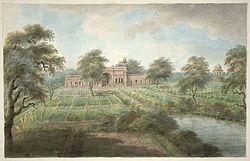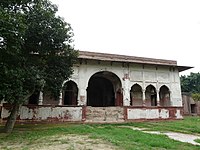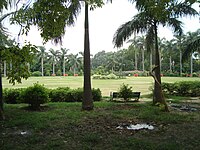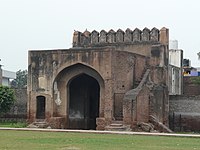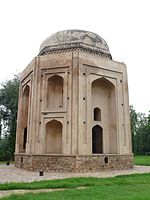|
Shalimar Gardens, Delhi
Shalimar Bagh also known as Shalimar Garden is a Mughal garden located on the banks of Yamuna river in Delhi, India. It was named as Aizzabad Bagh when the garden was laid by Izz-un-Nissa wife of Mughal emperor Shah Jahan in 1653 as a tribute and replica of Shalimar Bagh, Kashmir, laid by erstwhile Mughal emperor Jahangir in 1619, the Shalimar Bagh of Delhi is now abandoned but still houses shade trees, majestic parterre and structure such as the Sheesh Mahal and the garden pavilion. HistoryIn 1653, Izz-un-Nissa popularly known by the title "Akbarabadi Mahal" the third wife of Mughal emperor Shah Jahan commissioned the Aizzabad Bagh ("later renamed as Shalimar Bagh") in the then vicinity of Shahjahanabad (present-day Old Delhi). Within the Shalimar Bagh, Shah Jahan constructed "Sheesh Mahal" (crystal palace).[1] The Shalimar Bagh had witnessed events of historical significance such as in 1658 the coronation ceremony of Aurangzeb took place at the Sheesh Mahal. In 1738, Nadir Shah and his army encamped there on his route to Delhi. In 1803 Sir David Ochterlony a British Resident to the Mughal court at Delhi, selected Shalimar Bagh as his summer residence. During the Indian Rebellion of 1857 a battle was fought in very place when Delhi was sieged by the troops of East India Company.[2][3][4][5][6] In the Third Battle of Panipat, Ahmad Shah Durrani stayed there. DesignThis pavilion was built by the Mughal emperor Shah Jahan. Like most Mughal gardens, it had channels of water culminating in ornate tanks and several fountains. The layout is designed in the mughal style of chaharbagh style. The pavilion has patches of wall-paintings that survived till date.[1] The Sheesh Mahal (crystal palace) is built on a high plinth facing the parterre with 25 fountains and the surrounding garden consisted of fruit orchards. The archways are circular, the central hall consists with a compartment at either end and an arched hall at the rear. Attached to the main building are vaulted rooms. Painting marks exist on the ceiling.[1][7][8] Further reading
GalleryShalimar Bagh gallery
References
|
||||||||||||||||||||||||
